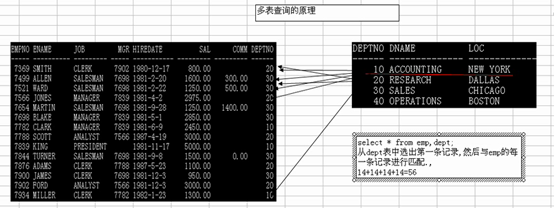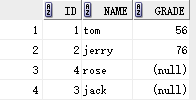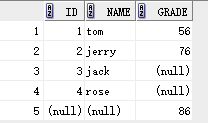Oracle表復雜查詢
Oracle表復雜查詢
聚合函數
max(字段值) -- 求最大值
min(字段值) -- 求最小值
sum(字段值) -- 求總和
avg(字段值) -- 求平均值
count(字段值) -- 求個數
group by 和 having 字句
group by : 用於對查詢的結果分組統計
having 子句:用於過濾分組顯示的結果
案例:
1.顯示每個部門的平均工資和最高工資?
select avg(sal),max(sal) from emp group by deptno
2.顯示每個部門的每種崗位的平均工資和最低工資?
select avg(sal),min(sal) from emp group by deptno,job
3.顯示平均工資低於2000的部門號和它的平均工資?
select avg(sal) deptno from emp group by deptno having avg(sal) < 2000;
多表查詢

原理:
笛卡兒積: 在多表查詢的時候,如果不帶任何條件,則會出現笛卡兒積現象。
規定: 多表查詢的條件至少不能少於表的個數-1;
案例:
1.顯示雇員名,雇員工資及所在部門的名字?
select e.ename,e.sal, d.deptno
from emp e,dept d
where e.deptno = d.deptno
order by d.deptno;
2.顯示部門號為10的部門名、員工名和工資?
select d.dname, e.ename, e.sa
l from emp e, dept d
where e.deptno = d.deptno and d.deptno = 10;
3.顯示各個員工的姓名,工資,及其工資的級別?
select emp.ename ,emp.sal , salgrade.grade
from emp,salgrade
where emp.sal between salgrade.losal and salgrade.hisal;
自連接
案例:
1.顯示“FORD”的上級?
select * from emp where emp.empno =
(select mgr from emp where ename = ‘FORD‘);
2.顯示各員工的姓名和他上級領導的姓名?
select worker.ename, boss.ename
from emp worker ,emp boss
where worker.mgr = boss.empno;
子查詢
定義
嵌入到其他sql語句的select語句,也叫嵌套查詢。
單行子查詢
定義: 返回一行數據的子查詢
案例:
如何顯示SMITH同一部門的所有員工?
select * from emp where emp.deptno =
(select deptno from emp where ename = ‘SMITH’) and ename != ‘SMITH‘;
多行子查詢
定義:返回多行數據的子查詢
案例:
顯示10號部門的工作相同的員工姓名,工作?
select ename,job from emp where job in (
select job from emp where deptno = 10);
all( 大於最大的):
如何顯示工資比30號部門高的員工的姓名、工資、部門號
select ename,sal,deptno from emp where sal > all(select sal from emp where emp.deptno = 30);
等效於
select ename,sal,deptno from emp where sal > (
select max(sal) from emp where deptno =30);
any( 大於最小的):
如何顯示工資比30號部門任意員工高的員工的姓名、工資、部門號
select ename,sal,deptno from emp where sal > anyl(select sal from emp where emp.deptno = 30);
等效於
select ename,sal,deptno from emp where sal > (
select min(sal) from emp where deptno =30);
多列子查詢
如何查詢與smith的部門和崗位完全相同的所有雇員
select * from emp where (deptno,job) =
(select deptno,job from emp where ename = ‘SMITH’);
----------------------------------------------------
註: “(deptno,job) =(select deptno,job ”是有順序的
from中的子查詢
定義: 將select查詢結果當作一個虛表處理
案例:
顯示高於自己部門的平均工資的員工信息?
select t1.ename, t1.sal,t2.myavg from
emp t1,( select avg(sal) myavg ,deptno from emp group by deptno) t2
where t1.deptno = t2.deptno and t1.sal > t2.myavg;
顯示每個部門的信息(編號,名稱) 和人數?
select t1.dname, t1.deptno,t2.num from dept t1 , (select count(*) num,deptno from emp group by deptno) t2
where t1.deptno = t2.deptno(+);
--------------------------------------------------------
(+) 在左表示右外連接,在右表示左外連接
分頁查詢
mysql:
select * from 表名 where 條件 limit 從第幾條取,取幾條
sql server:
select top 4 * from 表名 where id not in (select top 4 id from 表名 where 條件)
---------------------------
排除前4條,再取4條,實際上是5-8條
oracle:
格式:
select * from (select rownum rn,t1.* from (select * from 表名 [ where 條件]) where rownum <= 末尾) t2 where t2.rn >= 開始;
---------------------------
rownum:偽列,用於顯示數據的行索引。
select * from emp where rownum > = 3
說明: 因為oracle的行索引(rownum)是從第1開始索引的,所以不能用>=(條件無法成立),可以用<=。
解決: 采取截取結果集的方式,將已經查詢好的查詢結果再進行過濾。
三層:
第一層: select * from 表名 [ where 條件] --放條件,比如排序等
第二層: select rownum rn,t1.* from (select * from 表名 [ where 條件]) where rownum <= 末尾 --決定末尾位置
第三層: select * from (select rownum rn,t1.* from (select * from 表名 [ where 條件]) where rownum <= 末尾) t2
where t2.rn >= 開始; --決定開始位置
拓展:
復制表: create table mytest as select empno,ename,sal,comm,deptno from emp;
插入表:insert into mytest(empno,ename,sal,comm,deptno) select empno,ename,sal,comm,deptno from mytest;
內連接與外連接
內連接: 笛卡兒積過濾後的連接
案例:
select * from emp inner join dept on emp.deptno = dept.deptno;
等效於
select * from emp,dept where emp.deptno = dept.deptno
外連接:
案例:
測試表
學生表:
create table stu (id number,name varchar2(32));
insert into stu values(1,’tom’);
insert into stu values(2,’jerry’);
insert into stu values(3,’jack’);
insert into stu values(4,’rose’);
成績表
create table exam(id number,grade number(6,2));
insert into exam(1,56);
insert into exam(2,76);
insert into exam(11,86);
要求1:顯示所有人的成績,如果沒有成績,也要顯示該人的姓名和id號,成績為空
select stu.id,stu.name,exam.grade from stu inner join exam on stu.id = exam.id;
結果:

原因:在笛卡兒積連接之後,相同條件的才會匹配
左連接:select stu.id,stu.name,exam.grade from stu left join exam on stu.id = exam.id;
另一種寫法: select stu.id,stu.name,exam.grade from stu , exam where stu.id = exam.id(+);
結果:

原因:連接後的數據以左邊表為基準,即使對應的右邊沒有數據,也要顯示為空。
要求2:顯示所有成績,如果沒有名字匹配,顯示空
右連接:select stu.id,stu.name,exam.grade from stu right join exam on stu.id = exam.id;
另一種寫法: select stu.id,stu.name,exam.grade from stu , exam where stu.id(+) = exam.id;
結果:

原因:連接後的數據以右邊表為基準,即使對應的左邊沒有數據,也要顯示為空。
小結: 左右外連接可以互為轉換
比如:顯示所有成績,如果沒有名字匹配,顯示空
可以寫出:select stu.id,stu.name,exam.grade from exam left join stu on stu.id = exam.id;
案例3:顯示所有的成績和所有人的名字,如果沒有匹配值,就顯示空
完全外連接:兩個表查詢,不管有麽有匹配,都顯示。
select stu.id,stu.name,exam.grade from exam full outer join stu on stu.id = exam.id;
結果:

Oracle表復雜查詢
